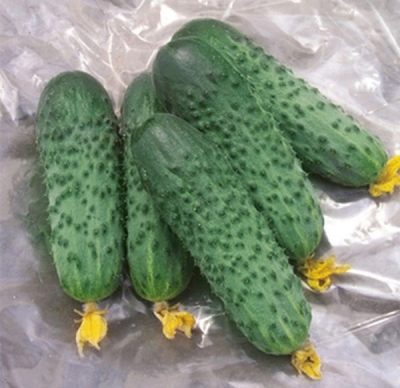
- Authors: NUNHEMS B.V.
- Name synonyms: Satina
- Year of approval: 2009
- Growth type: indeterminate
- Fruit weight, g: 88-108
- Fruit color: green with short stripes and slight mottling
- Cucumber Mosaic Virus Resistance: stable
- Ripening terms: ultra early or early
- Fruit shape: cylindrical
- Fruit taste: great
Cucumbers of the hybrid variety Satina of Dutch selection have recently appeared in the gardens of our country, but are already beginning to gain popularity. And this is facilitated by high yields, excellent taste, beautiful and neat appearance.
Breeding history
The homeland of the Satina cucumber hybrid is the Netherlands and the seed company NUNHEMS B. V. The crop was obtained by Dutch breeders not so long ago, in 2007. In the same year, the originators submitted an application for admission to growing in the Russian Federation. After successfully conducted variety trials, the hybrid received a "registration" in the State Register in 2009, it was zoned for two regions: the North Caucasus and the Lower Volga.
Description of the variety
Cucumbers representing the Dutch selection, as a rule, perfectly acclimatize in Russian gardens in any region. Satin is no exception. This culture does not require pollination, therefore it is not necessary to take care of the presence of pollinating insects near the beds. In general, the crop is recommended for industrial cultivation.
Characteristics of the appearance of plants and zelents
Satina bushes are distinguished by an indeterminate type of growth. Sizes and branching are average. The foliage of a rich dark green shade is quite large, it perfectly shades the fruit. The cucumbers themselves are cylindrical in shape, covered with thorns. Short, weighing an average of 88-108 grams. The color is green, with a slight spotting, closer to the flower, the color brightens, separate whitish strokes appear.
Purpose and taste of fruits
The Dutch cucumber has not only an ideal presentation, but also excellent taste characteristics. The fruits can be eaten fresh, made from them, pickled, salted. Suitable as pickles, if collected in the size of 3-5 cm, or as gherkins, removed 5-8 cm.
There are no voids in the pulp of these cucumbers, as well as bitterness. There is a good uniform density, crunch when eaten.
Maturation
The variety is characterized as ultra-early or early. The time that must elapse from the first shoots to the removal of a ripe cucumber from the bush is 35-45 days.
Yield
Average yields per hectare are in the range of 394-444 centners.
Growing regions
As already mentioned, since 2009 the crop has been recommended for cultivation in the territory of two regions. This is the North Caucasus (Chechen Republic, Ingushetia, Adygea, Dagestan, as well as Krasnodar, Stavropol Territories, Rostov Region). The second region was the Lower Volga, which includes Kalmykia and several regions: Saratov, Volgograd and Astrakhan.
Growing and care
The vegetable crop of the described variety is cultivated using one of two methods: seed or seedling. The first method is simpler, moreover, not as troublesome as seedling. Each gardener chooses the method that suits him best.
Caring for a varietal cucumber plantation will not be very different from caring for other crops. In any case, it is necessary to devote time to this.
Watering will be the main thing.Their frequency will depend on weather conditions: in dry months, irrigation is carried out for 3-5 days. In this case, you should check to what depth the soil has dried. If, for example, the ground has dried out by 2-3 cm, unscheduled moistening is also possible. The main thing is that the liquid should not be colder than the soil. For a Satin hybrid, it is preferable to arrange drip irrigation. It is better to spend it early in the morning or after sunset.
It is necessary to fertilize the variety before flowering, as well as during fruiting. For this, standard vegetable dressings are suitable. They should be applied to the root circle, and after they are absorbed and the soil is dry, the root area is loosened.
A culture from distant Holland is quite demanding for good ventilation of the soil, access to oxygen roots. It should be loosened very carefully around the stem.

In order to collect strong, tasty and beautiful cucumbers on your site, you need to make top dressing. Lack of nutrients can negatively affect the appearance of the plant and significantly reduce the yield. Fertilize cucumbers with organic fertilizers in combination with mineral fertilizers. With the right balance of these components and adherence to the fertilizing schedule, the cucumber yield will be maximum.
Disease and pest resistance
The resistance to many diseases in the Satin hybrid was laid down by breeders at the level of genetics. However, with illiterate watering from excess moisture, putrefactive root diseases can occur. The culture is resistant to such ailments as cucumber mosaic and bacteriosis.

Despite their popularity, cucumbers are often attacked by diseases and pests. From them, cucumber plantings often die before the start of fruiting. In order to prevent this from happening, it is necessary to try to prevent ailments or get rid of them at the very beginning, having studied in detail their causes of occurrence, signs and methods of treatment.





























































































